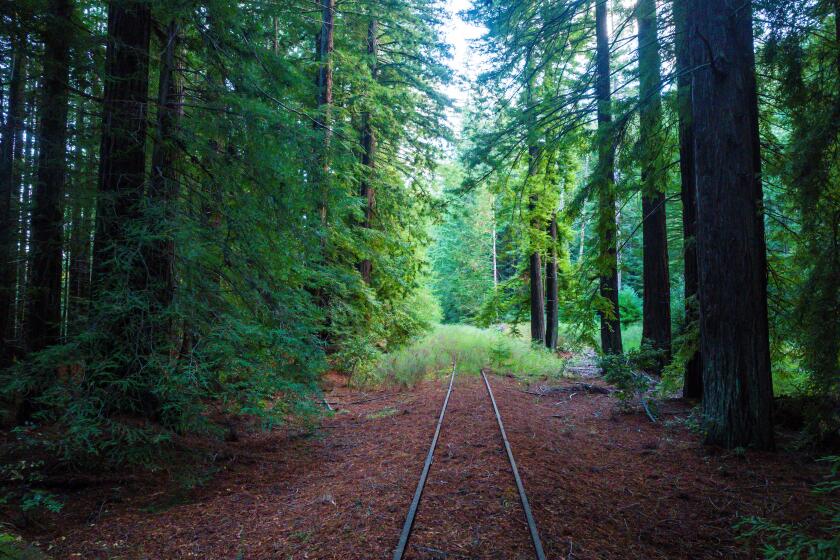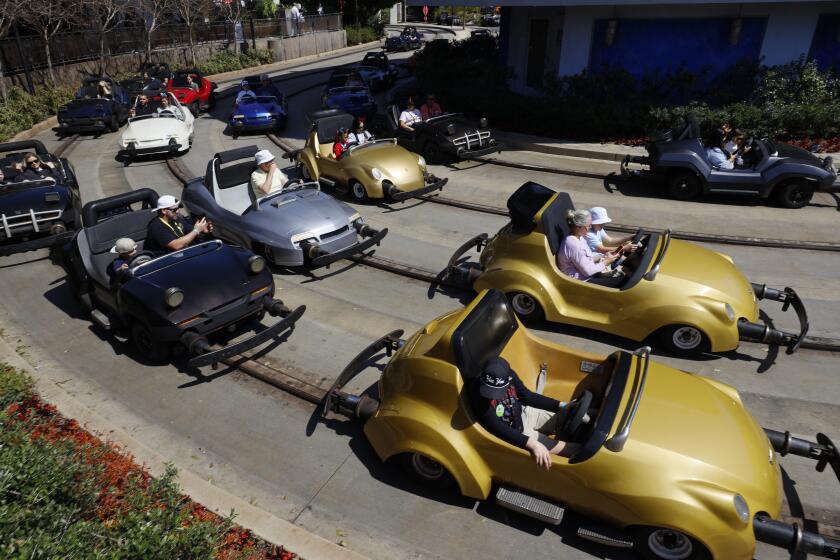In L.A., Desire of Some Is Named Streetcar
A new study that will probably reinvigorate a decades-old debate about mass transit in Los Angeles concludes that bringing back streetcars to downtown would spur more development and attract riders. It also contends that trolleys could peaceably share the road with cars.
The report, expected to be released this week by the Community Redevelopment Agency, also makes another point: Reintroduced trolleys have met with success in many other cities, and there’s no reason they can’t in Los Angeles.
In other cities, “the streetcars have inspired and promoted economic revival, they have encouraged and attracted tourism, and they have supplemented the existing, everyday public transit services already in operation,” concludes the study, which was written by several transportation consultants.
“This isn’t just a cute little tourist attraction,” said Carol Schatz, president and chief executive of the influential Central City Assn., which represents downtown businesses. “We need a sophisticated and fun circulator that ties together all the vibrant districts that are spread around downtown.”
While downtown is still heavily dotted with parking lots, a mini-construction boom is underway as new buildings are built and old offices are converted to residences. At least 7,600 residential units are in the development pipeline, the new L.A. Live entertainment complex is rising next to Staples Center and planning is underway for a Grand Avenue redevelopment project.
The study proposes connecting the southern and northern parts of downtown. Trolleys would run on tracks down the middle or the side of streets amid car traffic, and the streetcars would be powered by electricity from overhead wires.
There are hurdles, the most notable of which is the cost -- $60 million to $73 million.
There is also the matter of political will in City Hall, which oversees a metropolis where streetcars were removed, albeit four decades ago, to clear the way for more automobiles. Although the idea of bringing back streetcars has been around for years, this particular proposal comes not from transit organizations but from the redevelopment agency, which is tasked with reinvigorating downtown, among other areas. And it was Rep. Lucille Roybal-Allard (D-Los Angeles), not city officials, who corralled the $100,000 for the report.
Mayor Antonio Villaraigosa’s office declined to comment on the study or the idea of returning trolleys to the streets. The mayor has been pushing for a larger light-rail line that might run on surface streets and would traverse downtown to connect the existing Long Beach and Pasadena light-rail routes to future lines to the Westside and East Los Angeles.
Streetcars hold a special place in the history of Los Angeles. The streetcar system in Southern California, which blossomed in the late 1800s, once had over 1,000 miles of track, with Los Angeles at the center. But civic leaders preferred buses, and streetcars had difficulty competing with the door-to-door convenience of automobiles in a growing and sprawling region.
After the final five lines were shut down on March 31, 1963, most of the rolling stock was sold to the transit system in the Egyptian capital of Cairo, and the Los Angeles Convention Center eventually occupied the site of the city’s old trolley yards.
But why spend millions for a trolley system when the city already has a fleet of DASH buses circulating downtown? The buses, after all, don’t require tracks or power lines and offer more route flexibility.
Streetcar advocates argue that people who don’t like riding buses are more willing to ride aesthetically pleasing streetcars, which are usually quieter and don’t weave in and out of traffic. They also believe that streetcars, like other fixed-route lines, lure development.
“There’s something about the reliability and obviousness of a rail line that trumps the bus every time,” said Gloria Ohland, a vice president with Reconnecting America, a group dedicated to building housing near rail stations. “And obviously it works for developers because they see rail lines in the street and they know the public sector has made a commitment to that neighborhood.”
Streetcars have become something of a rage in urban planning circles. Seattle; Memphis, Tenn.; Little Rock, Ark.; Charlotte, N.C.; Dallas and Portland, Ore., have brought back trolleys in recent years and Atlanta is seriously considering doing so. Closer to home, the Port of Los Angeles opened a 1.5-mile trolley line in 2003 as a tourist attraction.
Perhaps the most talked about is in Portland, where a six-mile trolley line traverses a neighborhood known as the Pearl that until the 1990s was rail yards. After it was rezoned to allow for housing to be built, the area has thrived with new lofts and businesses. The addition of the trolley, in 2001, helped, advocates say.
“Since 1997, when the city committed to build the trolley, until today, there has been $2.3-billion worth of investment near the trolley, 7,248 residential units have been built and another 4.6 million feet of commercial space,” said Vicky Diede, the project manager for Portland Streetcar.
Diede said that the most impressive statistic for her agency is that prior to the streetcar project, most of the development near the future line was built at half the allowable density. Since the project, she said, new buildings within one block of the line are at 90% of the potential density -- meaning that the real estate has become much more desirable.
In Los Angeles, the new study is only a beginning, and the CRA has not yet taken a position. If there’s a push to go forward, another study will be needed to work out some of the more technical aspects and to settle on a route.
Schatz said that although downtown businesses would probably be willing to shoulder some of the financial load, the city probably would need to come up with at least $40 million at a time when federal funding for trolleys is in short supply.
“I don’t think it’s a pipe dream,” said Councilwoman Jan Perry, whose district includes much of downtown. “When you look at all the new buildings coming on line here, I think that anything that could serve residents and tourists, and reduces the number of car trips, can’t just be rejected.”
Waiting for some type of resolution are people such as Jim Walker, who in the final days of the streetcar system in Los Angeles spent some of his free time photographing the trolleys as they scooted about town.
After the last train rolled, he avoided downtown. “I just closed the door because I didn’t want to see the destruction,” said Walker, 70, who is now the historian for the Metropolitan Transportation Authority.
“I didn’t think they would ever come back,” Walker added. “But a lot of things happened since then that I never thought would, and I guess I still have some faith.”
More to Read
Start your day right
Sign up for Essential California for news, features and recommendations from the L.A. Times and beyond in your inbox six days a week.
You may occasionally receive promotional content from the Los Angeles Times.






